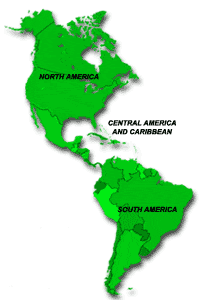Aims of the website
After using this website, you will be able to:
- Describe the main attractions of the entire Americas region
- Understand the ranging climates throughout the region
- Describe inbound tourism flows and where international visitors are coming from
The Americas is an immense region, in terms of its physical features as well as its social and cultural diversity. According to UNWTO (2013), the composition of the Americas is split into numerous sub-regions which are:
- North America
- Caribbean
- Central America
- South America
(Google Images, 2014)
One distinctive feature of the region is its climate. The entire region stretches between two polar zones (Park, 2014) which means the climate is extremely varied. It tends to be hot and humid in the central parts whilst there are warmer and cooler temperate zones in the North and South. These varied climates ensure that tourism is viable all year round, with ‘sun and sea’ holidays occurring in the warmer destinations whilst cultural/rural tourism is more suited to the cooler climates.
There is also a large amount of tourist attractions across the whole of the Americas. Many of them can be found in the USA with Disneyland and the Statue of Liberty being popular choices. In addition to this, there is a wide range of natural tourist attractions such as the Grand Canyon and Niagara Falls. However, it does not stop there; there are many cultural/historic tourist attractions with many of them being in Central and South America. This varied amount of visitor attractions ensures that the region does not cater to just one type of tourist; it caters for everyone whether it be families, honeymooners or people interested in eco-tourism.
Despite tourism growing across the globe, the Americas, particularly North America, remains a traditional favourite. North America dominates the region in terms of international tourist arrivals, with 102.1 million visitors in 2011 compared to Central America’s 8.3 million (UNWTO, 2013). Despite North America being the predominant region, the Americas experienced a sustained growth rate, with a 5% increase in arrivals; in other words, an increase of 7 million (UNWTO, 2013).
This website will explore a variety of the region’s features such as its tourism flows, its climate and visitor attractions to give people a deeper insight into tourism in the Americas.
